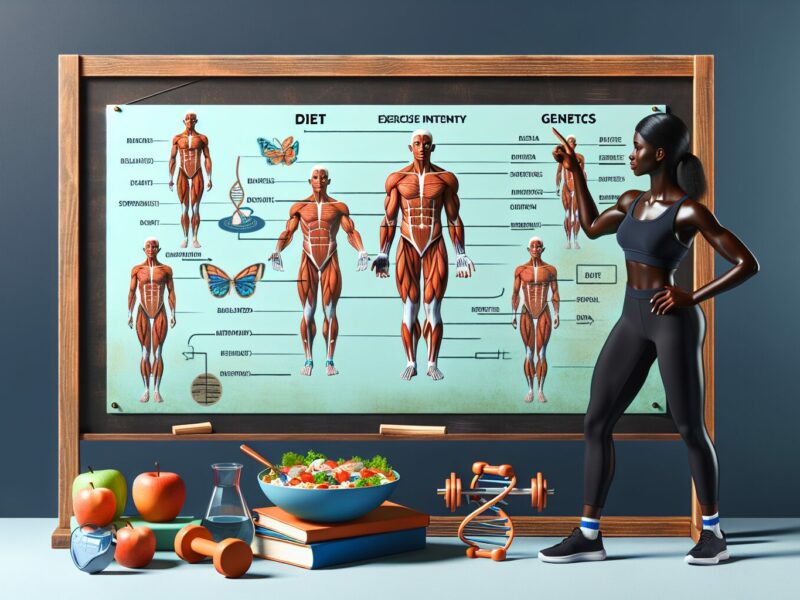Have you ever wondered how you can increase your muscle mass? Whether you’re a woman, man, or older adult, building muscle can have numerous benefits for your overall health and well-being. In this article, we will explore some effective strategies and techniques that can help you on your muscle-building journey, regardless of your age or gender. So, if you’re ready to gain strength, boost your metabolism, and achieve a toned and sculpted physique, keep reading to discover the secrets to building muscle mass as a woman, man, or older adult.
1. Understanding Muscle Mass
Muscle mass refers to the amount of muscle tissue in your body. Understanding muscle mass is essential for anyone looking to build and maintain strong, healthy muscles. There are different types of muscle fibers that make up your muscle mass, including slow-twitch and fast-twitch fibers.
1.1 Types of Muscle Fibers
Muscle fibers can be categorized into two main types: slow-twitch and fast-twitch fibers. Slow-twitch fibers are responsible for endurance activities, such as long-distance running or cycling. They are more resistant to fatigue and generate less force than fast-twitch fibers. On the other hand, fast-twitch fibers are responsible for explosive movements and generate more force, but they fatigue more quickly.
1.2 Importance of Muscle Mass
Having sufficient muscle mass is crucial for overall health and well-being. Muscles play a vital role in maintaining strength, stability, and mobility. They are responsible for supporting your body, protecting your joints, and facilitating movement. Muscle mass is also closely linked to metabolism, as muscles burn more calories at rest than fat tissue. Increasing muscle mass can help boost your metabolism and support weight management goals.
1.3 Differences in Muscle Mass Between Genders
There are inherent differences in muscle mass between genders due to hormonal and genetic factors. Men typically have a higher muscle mass than women, primarily due to higher levels of testosterone. However, it’s important to note that women can still build significant muscle mass through proper training and nutrition strategies. Women have unique advantages when it comes to muscle building, such as a higher percentage of slow-twitch fibers, which can enhance endurance and recovery.
1.4 Changes in Muscle Mass with Aging
As we age, there is a natural decline in muscle mass and strength known as sarcopenia. This loss of muscle mass is more pronounced in older adults who lead sedentary lifestyles or have poor nutrition habits. However, engaging in regular resistance training and maintaining a well-balanced diet can help mitigate muscle loss and preserve muscle mass as you age.
2. Setting Goals for Muscle Building
Before embarking on a muscle-building journey, it’s essential to set clear and achievable goals. This will help guide your actions and ensure you stay motivated throughout the process.
2.1 Assessing Current Fitness Level
Start by assessing your current fitness level. This includes evaluating your strength, endurance, flexibility, and overall health. By understanding where you are starting from, you can tailor your training program to suit your needs and abilities.
2.2 Determining Personal Fitness Goals
Next, determine your personal fitness goals. These goals can vary widely depending on individual preferences and aspirations. Whether you aim to increase muscle size, improve strength, or enhance overall fitness, setting specific and realistic goals will provide you with a clear direction.
2.3 Establishing Realistic Timelines
When setting muscle-building goals, it’s crucial to establish realistic timelines. Building muscle takes time and consistency, so it’s important to be patient with the process. Setting short-term and long-term milestones can help you stay focused and track your progress along the way.
3. Nutrition for Muscle Growth
Proper nutrition is paramount when it comes to building muscle mass. A well-balanced diet that provides an adequate amount of macro and micro nutrients is essential for muscle growth and repair.
3.1 Macro and Micro Nutrients for Muscle Building
To support muscle growth, focus on consuming sufficient amounts of protein, carbohydrates, and healthy fats. Protein is particularly important for muscle repair and synthesis, so include lean sources like chicken, turkey, fish, tofu, and legumes in your diet. Carbohydrates provide energy for workouts, and fats play a role in hormone production and joint health. Additionally, don’t forget to include a variety of fruits and vegetables to ensure you’re getting the necessary vitamins and minerals.
3.2 Benefits of Protein for Muscle Mass
Protein is the building block of muscle tissue and plays a crucial role in muscle growth. Consuming an adequate amount of protein can help promote muscle protein synthesis and aid in recovery after exercise. Aim to consume around 0.8-1 gram of protein per pound of body weight per day, spread throughout your meals and snacks.
3.3 Importance of Caloric Surplus
To gain muscle mass, it’s necessary to consume a surplus of calories. This means consuming slightly more calories than your body burns each day. However, it’s essential to strike a balance and avoid excessive calorie intake, as this can lead to fat gain instead of muscle growth. Aim for a moderate calorie surplus of around 250-500 calories per day to support muscle growth while minimizing fat gain.
3.4 Hydration
Proper hydration is often overlooked but is crucial for optimal muscle growth and overall health. Dehydration can impair muscle function and reduce exercise performance. Aim to drink enough water throughout the day to stay adequately hydrated, especially during workouts.
4. Resistance Training
Resistance training is the cornerstone of muscle building. By incorporating progressive overload and variation in exercises, you can stimulate muscle growth and strength gains.
4.1 Why Resistance Training is Essential for Muscle Growth
Resistance training, such as weightlifting or bodyweight exercises, is essential for muscle growth because it creates a stimulus that triggers the body’s adaptive response. When you subject your muscles to resistance, it causes small micro-tears in the muscle fibers. Through the recovery process, your muscles repair and rebuild, resulting in increased muscle mass and strength.
4.2 Choosing the Right Type of Resistance Training
There are various options for resistance training, including free weights, weight machines, resistance bands, and bodyweight exercises. Each has its advantages and can be incorporated into a well-rounded training program. Experiment with different types of resistance training to find what works best for you and your goals.
4.3 Frequency and Volume of Training
The frequency and volume of your resistance training workouts play a crucial role in muscle growth. Aim for 2-4 resistance training sessions per week, targeting all major muscle groups. It’s important to allow for adequate recovery between workouts to avoid overtraining and facilitate muscle repair and growth.
4.4 Progressive Overload and Variation in Exercises
To continue stimulating muscle growth, it’s essential to incorporate progressive overload into your resistance training routine. Progressive overload involves gradually increasing the demands placed on your muscles over time. This can be achieved by increasing the weight, the number of repetitions, or the intensity of your exercises. Additionally, varying your exercises can prevent plateaus and keep your workouts challenging and exciting.
5. Weightlifting Techniques for Muscle Building
When it comes to weightlifting, proper form and technique are paramount. By performing exercises correctly, you can maximize muscle activation and minimize the risk of injury.
5.1 Compound Exercises vs. Isolation Exercises
Both compound and isolation exercises have their place in a muscle-building program. Compound exercises, such as squats, deadlifts, and bench presses, involve multiple muscle groups and are great for overall strength and muscle development. Isolation exercises, such as bicep curls or tricep extensions, target specific muscle groups and can be effective for targeting muscle imbalances or weaknesses.
5.2 Proper Form and Technique
Maintaining proper form and technique is crucial to ensure effective muscle activation and prevent injury. When performing exercises, focus on maintaining a neutral spine, engaging the targeted muscle group, and avoiding excessive momentum or compensatory movements. If you’re new to weightlifting, consider working with a qualified trainer to learn proper technique and form.
5.3 Repetition Ranges and Load Variation
To stimulate muscle growth, it’s important to vary your repetition ranges and load. Different repetition ranges, such as low (1-5 reps), moderate (6-12 reps), and high (12+ reps), target different muscle fibers and adaptations. Utilize a mix of repetition ranges and gradually increase the load (weight) as your strength and form improve.
5.4 Recovery and Rest Days
Allowing for adequate recovery and rest days is crucial for muscle growth. Your muscles need time to repair and rebuild after intense weightlifting sessions. Aim to get 1-2 rest days each week and prioritize quality sleep to support the recovery process.
6. Cardiovascular Exercise for Muscle Building
While resistance training is the primary focus for muscle building, cardiovascular exercise can still play a supportive role in your overall fitness routine.
6.1 Benefits of Cardiovascular Exercise
Cardiovascular exercise, such as running, cycling, or swimming, offers numerous benefits for muscle building. It improves cardiovascular health, enhances endurance, supports recovery, and aids in managing body fat levels. Including cardiovascular exercise in your routine can help optimize overall fitness and contribute to muscle growth indirectly.
6.2 Finding the Balance between Cardio and Resistance Training
Finding the right balance between cardiovascular exercise and resistance training is important. If you’re primarily focused on building muscle, prioritize resistance training and limit cardiovascular exercise to avoid excessive calorie expenditure. Aim for 2-3 cardiovascular workouts per week, focusing on shorter, higher-intensity sessions like interval training.
6.3 High-Intensity Interval Training (HIIT)
High-Intensity Interval Training (HIIT) is a time-efficient and effective way to incorporate cardiovascular exercise into a muscle-building routine. HIIT involves short bursts of intense exercise followed by periods of active recovery. This type of training can help improve cardiovascular fitness while also stimulating muscle growth by engaging multiple muscle groups.

7. Rest and Recovery
Rest and recovery are often underestimated but are essential components of any muscle-building program. Without proper rest and recovery, your muscles may not have sufficient time to repair and grow.
7.1 Importance of Rest and Recovery
Rest and recovery are crucial for muscle growth because it allows your body to repair and rebuild muscle tissue. During rest periods, your body adapts to the stimulus provided during resistance training, making your muscles stronger and more resilient. Adequate rest also helps prevent overuse injuries and reduces the risk of burnout.
7.2 Sleep and its Impact on Muscle Growth
Quality sleep is essential for optimal muscle growth and recovery. During sleep, your body releases growth hormone, a key player in muscle repair and growth. Aim for 7-9 hours of uninterrupted sleep each night to support muscle-building efforts.
7.3 Active Recovery Techniques
In addition to rest and sleep, incorporating active recovery techniques can further enhance muscle recovery. These techniques can include light exercise, foam rolling, stretching, or low-impact activities like yoga or Pilates. Engaging in active recovery on rest days can help improve blood circulation and alleviate muscle soreness.
8. Hormonal and Lifestyle Factors
Hormonal balance and lifestyle factors can significantly impact muscle building. Understanding and addressing these factors can optimize muscle growth and overall well-being.
8.1 Importance of Hormonal Balance for Muscle Building
Hormones play a crucial role in muscle growth and development. Testosterone, growth hormone, and insulin-like growth factor (IGF-1) are key hormones involved in muscle synthesis. It’s important to have a balanced hormonal profile to support muscle-building efforts. However, hormonal imbalances can occur due to factors such as stress, inadequate nutrition, or age-related changes.
8.2 Effect of Age on Hormonal Balance
As you age, there may be changes in your hormonal balance that can affect muscle building. Testosterone levels gradually decline in both men and women with age, which can impact muscle mass and strength. However, regular resistance training, proper nutrition, and adequate rest can help mitigate the effects of age-related hormonal changes and promote muscle growth.
8.3 Stress Reduction Techniques
Chronic stress can negatively impact muscle building due to increased cortisol levels. High levels of cortisol can lead to muscle breakdown and hinder muscle growth. Incorporate stress reduction techniques such as meditation, deep breathing exercises, or engaging in hobbies to manage stress levels and support muscle-building efforts.
8.4 Avoiding Overtraining
Overtraining occurs when the body is subjected to excessive stress without adequate recovery. This can lead to muscle damage, decreased performance, and hindered muscle growth. It’s important to listen to your body and avoid overtraining by allowing for sufficient rest days and adjusting your training intensity when necessary.
9. Overcoming Challenges and Barriers
Embarking on a muscle-building journey may come with challenges and barriers. However, with the right mindset and strategies, you can overcome them and continue progressing towards your goals.
9.1 Patience and Consistency
Building muscle takes time and consistent effort. It’s important to be patient and stay committed to your training and nutrition plan. Results may not happen overnight, but with persistence, you will see progress over time.
9.2 Addressing Muscle Imbalances and Weaknesses
Identifying and addressing muscle imbalances or weaknesses is crucial to prevent injuries and promote balanced muscle development. Incorporate exercises that target specific muscle groups or work with a qualified trainer to create a personalized program that addresses your individual needs.
9.3 Seeking Professional Guidance
If you’re new to muscle building or facing challenges that hinder your progress, seeking guidance from a qualified fitness professional can be beneficial. They can provide personalized advice, help with programming, and ensure you are using proper techniques to maximize your muscle-building potential.
10. Tracking Progress and Adjusting
To ensure you are on the right track and making progress, it’s important to track your muscle-building journey and adjust your training and nutrition approaches if necessary.
10.1 Measuring Muscle Mass and Body Composition
Measuring muscle mass and body composition can provide valuable insights into your progress. Methods such as body fat calipers, bioelectrical impedance, or DEXA scans can help assess changes in muscle mass and body fat percentage over time. Regularly tracking these metrics can help you make informed decisions about your training and nutrition approach.
10.2 Documenting Strength and Performance Improvements
In addition to tracking body composition, documenting strength and performance improvements can also provide evidence of progress. Keep a workout journal or use a fitness tracking app to record your exercises, sets, reps, and weights. This will allow you to see how your strength and performance are improving over time.
10.3 Adapting Training and Nutrition Approaches
As you progress in your muscle-building journey, it’s important to periodically reevaluate and adjust your training and nutrition approaches. This could involve modifying your workout routine, increasing the difficulty or intensity of exercises, or adjusting your nutrient intake based on your goals and progress. Regularly reassessing and adapting will help you continue to challenge your muscles and stimulate growth.
Building muscle mass as a woman, man, or older adult is achievable with the right knowledge and approach. By understanding the fundamentals of muscle growth, setting clear goals, following a well-balanced nutrition plan, engaging in resistance and cardiovascular training, prioritizing rest and recovery, addressing hormonal and lifestyle factors, overcoming challenges, and tracking progress, you can embark on a successful muscle-building journey and achieve the strong, healthy body you desire. Stay committed, stay consistent, and enjoy the process of becoming stronger and more empowered through building muscle mass.




